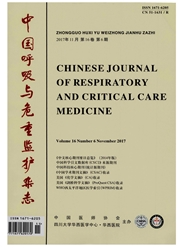

 中文摘要:
中文摘要:
目的探讨不同潮气量机械通气对大鼠膈肌放电的影响。方法将24只SD大鼠随机分为大潮气量组(10 m L/kg)、小潮气量组(5 m L/kg)和对照组。大潮气量组和小潮气量组大鼠进行不同潮气量的容量控制通气4 h,对照组麻醉后进行自主呼吸。在0、2、4 h分别测定大鼠膈肌放电情况,并监测血压、经皮血氧饱和度(Sp O2)及呼气末二氧化碳分压(Pet CO2),分析大鼠膈肌放电在不同潮气量和通气时长下的变化趋势以及Sp O2、Pet CO2与膈肌放电之间的关系。结果与对照组比较,大潮气量组膈肌放电频率降低,膈肌放电面积增大,膈肌放电振幅×膈肌放电频率(A×R)差异无统计学意义;而小潮气量组膈肌放电频率及膈肌放电面积无显著差异,仅膈肌放电振幅×膈肌放电频率(A×R)明显升高。Sp O2在对照组及大潮气量组有所下降,Pet CO2在大潮气量组也有所下降,其余各指标没有显著变化。结论不同潮气量机械通气对大鼠膈肌放电的影响不同,小潮气量机械通气可以兴奋呼吸中枢,增强膈肌放电,而大潮气量则表现为抑制效应。
 英文摘要:
英文摘要:
Objective To explore the effects of volume mechanical ventilation with different tidal on the diaphragm discharge in rats. Methods Twenty-four SD rats were randomly divided into three groups,namely a high tidal volume group,a low tidal volume group,and a control group. The rats in the high tidal volume group and the low tidal volume group underwent volume controlled ventilation with tidal volume of10 m L / kg and 5 m L / kg, respectively. The rats in the control group breath spontaneously after anesthetization. The EMGdi frequency,diaphragm discharge area,product of diaphragm discharge amplitude and diaphragm discharge rate( A × R) were measured every 2 hours to analyze the characteristics of diaphragm of rats under different duration of ventilation. Results Compared with the control group,there was no statistical difference of A × R in the high tidal volume group,but the frequency of the diaphragm discharge reduced and the discharge diaphragm area increased. When compared the low tidal volume group with the control group,only the A × R increased significantly. The transcutaneous oxygen saturation( Sp O2)and end-tidal CO2pressure( Pet CO2) in the high tidal volume group decreased significantly compared to the control group while the other indexes had no difference. Conclusions The effects of mechanical ventilation with different tidal volume on the rat diaphragm discharge are different. The low tidal volume mechanical ventilation can excite the respiratory center and strengthen the diaphragm discharge with the stabilization of physiological index while the high tide volume inhibits diaphragm function and damages the oxygenation.
 同期刊论文项目
同期刊论文项目
 同项目期刊论文
同项目期刊论文
 期刊信息
期刊信息
